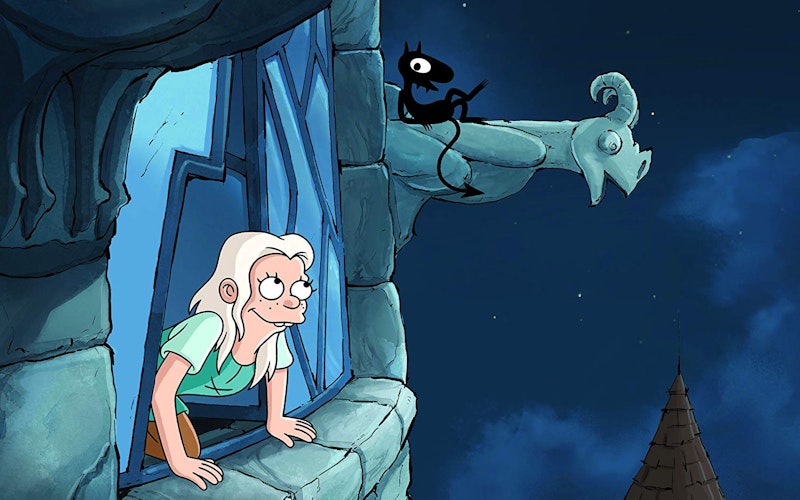
TV
Disenchantment’s Luci: Our Latest Screen Demon
“Four o’clock and all is well. Actually, ‘well’ is a bit of an overstatement. Acceptable is more like it, if you consider death, disease, and rampant poverty acceptable.”
So says the sarcastic town crier, setting the tone for Disenchantment, a new Netflix animated sitcom from Matt Groening, the creator of The Simpsons and Futurama. Set in the medieval fantasy kingdom of Dreamland, Groening’s darkly comic show aims to deconstruct the literary tradition of fairy tales. It’s an anti-Tolkien of sorts. Snarky and cynical, Disenchantment centers on an unlikely trio: Princess Bean (voiced by Abbi Jacobson), a teenage princess prone to drinking a lot of alcohol and rebelling against her royal duties; Elfo (Nat Faxon), a melancholic candy-loving elf who leaves his elven home to roam the world; and Luci (Eric Andre), Bean’s personal demon friend/tempter sent by two mages to drive Bean towards darkness.
In perhaps a nod to C.S. Lewis’s The Screwtape Letters, Bean is Luci’s first assignment as a demon. Unlike Lewis’ Wormwood, Luci receives no epistolary bits of advice on how to lure Bean into sin. But he doesn’t really need it, considering a simple chant of “do it, do it, do it!” into Bean’s ear is all it takes to tip her over the edge into mischief and rebellion.
Watching Luci at work, I wondered: what would a pop-culture demonology look like? How have demons been depicted in our popular imagination? For my purposes here (and for the sake of space!), I’ll only focus on demons in television and as distinct from the Devil or Satan (sorry, Hellboy and Black Phillip).
In TV, there are funny, comedic demons (The Good Place, Disenchantment); action-packed stories of demon hunters (Buffy the Vampire Slayer, Angel, Supernatural, Charmed, Preacher); sci-fi demons (the demogorgon of Stranger Things, various episodes of The X-Files); and horrific demonic possession narratives (American Horror Story). If you want to include “genies” as demons—“jinn” are spirit beings in Arabian and Islamic mythology—there’s I Dream of Jeannie. Luci is a comic demon, a small black cat-like entity who smokes, drinks, enjoys tormenting others, and is pretty lazy. He’s a spirit drunk on spirits. Yet Luci possesses a modicum of conscience; he genuinely cares about Bean and Elfo, and expresses remorse when they’re not around.
What would a pop-culture demonology look like?
TV demons are usually human-like, although they are physically more powerful than humans and often have a capacity beyond mere corporeality. They are spirits manifested with bodies, sometimes described as “fallen angels,” and often can change their appearance or possess humans. One can stop or get rid of a demon in a number of ways. Sometimes brute violence is all it takes; more often, it requires calling on a higher spiritual power, an exorcism. In the third episode of Disenchantment, “The Princess of Darkness,” Bean’s father, King Zog, hires an exorcist to drive out the demon from Bean. Of course, they let Bean’s “talking cat,” Luci, observe the exorcism. The exorcist eventually captures Luci, taking him and other detained demons to be tossed into a volcano. (Apparently fire kills demons?) Bean and Elfo save Luci from damnation by magma; after all, what are friends for?
Despite a few similarities, Luci really isn’t like the demons of Supernatural or Buffy: he’s small, squirrelly, more a nuisance than a true threat. Where else might we see this portrayal? We can turn to the history of Christian art, where the rendition of devils and demons have ranged in depiction. In The Oxford Dictionary of Christian Art and Architecture, the entry on “Devil” states: “The earliest representations show devils as basically human, but with wings and usually dark blue or purplish in colour.” Elsewhere, the dictionary describes medieval artistic representations of demons as “assistants to the Devil … usually half-human, half-animal, grinning ferociously as they herd the damned into Hell.” TheDictionary of Christian Art describes these tormenters of souls being “imaged as small animals, especially as cats or monkeys, or in horrific shapes … seen whispering in the ears of those being tempted.” This description matches the devilish figures in the paintings of Hieronymus Bosch (The Last Judgment) and Pieter Bruegel the Elder (The Fall of the Rebel Angels).
Dark color. Small cat-like animal. Grinning ferociously. Whispering temptations into the ears of those they torment. Yep, that sounds like Luci. Perhaps Groening’s deconstructive demon is more traditional than he imagined. If we can’t find inspiration for Luci in Buffy, we need only look to Bosch and Bruegel.
So, why this fascination with the demonic in popular imagination? Perhaps demons externalize what is internal—they serve as our fears and sins personified. With Luci, what could/should be seen as bad behavior is treated as comic, even praiseworthy. He is less a tempter and more an affirmer, encouraging Bean in the rebellious actions she already wants to do. Whether you believe in actual demons or not, consider this: do sinful behaviors stem mainly from outside influences and temptations or (perhaps more alarming) do sinful behaviors emerge from within our own minds and hearts? Either way, there is good news: whatever demons we face, we also know a savior, one who can rescue us from the dominion of darkness and bring us into the kingdom of the Son.
Topics: TV